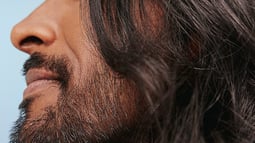

7 habits to get rid of oily hair
Photos Abaca
Words Anthony Vincent
Share the article on
Our tips for getting rid of greasy locks and making your hair and scalp healthy again.
Sebum is often considered the main culprit when it comes to oily hair. This is in part a mistake as the body produces sebum to protect the hair. It only becomes a problem when too much of it is secreted: it suffocates the scalp and makes hair oily. Your locks then become as flat and as shiny as Professor Severus Snape’s hair in Harry Potter.
What causes oily hair?
While hair can be oily due to genetic reasons, more often than not, its greasy state is lifestyle-related: unsuitable, too frequent and/or aggressive shampoos, pollution, anxiety, or favorite-football-team-induced stress activate the sebaceous glands which get carried away and produce excess sebum. Therefore, even freshly washed hair will quickly look dirty. Natural greasiness is hard to get rid of.
Habit number 1: Wash your hair less often
Resisting the urge to wash your hair every day to get rid of its shininess will rebalance sebum production. Using a gentle, sulfate-free shampoo avoids damaging the scalp, which will not need to defend itself by producing oil. Please note that this technique applies to your scalp only. We don’t recommend using oil as a means of defense in everyday life.
Sebocytine is a sebo-regulating agent extracted from rosehip berry. It’s one of the active ingredients in our Normal to Oily Hair Shampoo. It will allow you to wash your hair every other day for the first few weeks, and then every third day. Little by little, you’ll find that this shampoo does its job so well that washing your hair less will be effortless.
Habit number 2: Use a strengthening and moisturizing conditioner
After rinsing off the shampoo, apply the conditioner on wet hair, and let it rest for 2 to 3 minutes. This is an opportunity to wash the rest of your body while reflecting on Paul Pogba’s debatable hairstyles before rinsing off and revealing softer, stronger, more manageable hair. The ginseng in our Conditioner stimulates the scalp and improves your hair’s health. Its shea butter nourishes and soothes the scalp, which then doesn’t need to produce as much sebum. Your scalp will no longer itch, you’ll therefore be less tempted to put your (dirty) hands on it, and your hair won’t get greasy as quickly. Makes sense, right?
Habit number 3: Rinse with cold water and towel dry.
The warmer the water, the more it will dry your scalp and stimulate the sebaceous glands, which will increase their sebum production. Rinsing off shampoo and conditioner with cold water will prevent this from happening and add shine to your hair. A cool shower will tighten the hair’s cuticles, which in turn will make your mane look less dull.
The same applies to the heat of a hairdryer, which is aggressive to the scalp. Squeezing out most of the moisture in a towel and letting the rest air dry will help keep your hair healthier.
Habit number 4: fingers off!
As we said before, excessive scalp fiddling stimulates the sebaceous glands. When applying your shampoo and conditioner, massaging the product in quickly to distribute it evenly is enough. Make sure to alternate between the fingers and the palms of your hands to avoid stimulating excess sebum production. The same applies for the rest of the day: if and when your scalp itches, resisting the temptation to scratch that itch will keep your scalp from becoming greasy again. Keeping your hands away from your hair will spare it from the dirt and sebum your fingers carry.
Habit number 5: Use styling products that wash off without shampoo
It isn’t easy to wash your hair less when you use styling products. That doesn’t mean it’s impossible, though. Some products can be rinsed off just with water, so you don’t have to use shampoo to remove them. Our wax pomade provides a strong hold and a matte finish that’s ideal for oily hair. The clay it contains absorbs excess sebum to keep your hair looking clean.
Habit number 6: regularly wash your comb, brush, and pillowcase
We tend to forget that excess sebum can accumulate on the tools used to style our hair. It’s a shame to wash your hair only to immediately make it greasy again by styling it with a dirty comb or brush. Clean them once a week to make sure they stay clean. On days you haven’t shampooed, your pillowcase will also absorb some of the sebum, which it then keeps and spreads back on your hair after you’ve washed it. Changing your pillowcase at least once a week makes a world of difference and will even help keep your skin clean: two birds with one pillowcase. Take this opportunity to change your bedsheets too: dead skin cells and other residues love to accumulate on bedding, thereby turning your bed into a nightclub for bacteria. This will also allow you to change the background of your morning selfies: #IWokeUpLikeThis.
Habit number 7: absorb excess grease with talcum powder or dry shampoo
In addition to all these basic tips, you can take things further with two last resort products. If you sprinkle it sparingly on the hair roots, talcum powder will absorb excess sebum on the days you don’t wash your hair, and a comb or brush stroke should be enough to remove any white streaks. Dry shampoo is pretty similar: spray it on your hair roots from 20cm away, and your hair will look like it’s just been washed. While its name suggests otherwise, dry shampoo doesn’t clean the hair but simply helps it last that one more day until the next time you wash it. The show must go on.
Instead of waging war on grease with an aggressive daily shampoo, focus instead on moisturizing and soothing the scalp. It will secrete less sebum, and you will finally be able to make peace with your hair. It turns out miracle cures do exist!














